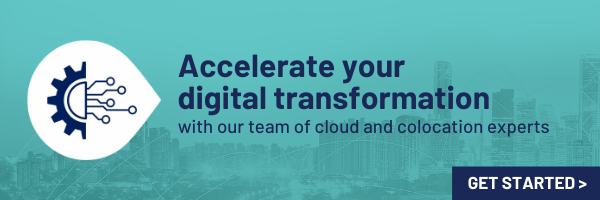August 05
With ever-advancing technology, the data center industry is always evolving to meet the needs of consumers. Two of the most transformative advancements of the last decade include the ubiquity of cloud and edge computing.
Both of these tools allow users to store and utilize data, significantly improving their experiences and enhancing if not replacing legacy systems.
In a previous blog post, we explored the key differences between cloud and edge computing. Read the article here for more information on how these systems differ.
Below, we’ll break down edge vs cloud computing and discuss how they can work together to deliver competition rattling workloads that delight customers.
Edge Computing vs Cloud Computing
What Is Edge Computing?
Edge computing architecture shifts key processing tasks away from a centralized location and pushes them to servers and devices on the outer “edges” of the network.
Under this framework, much of the data being gathered from edge endpoints never makes its way back to the network core for processing and analysis. Instead, this data is processed almost immediately by local computing resources, allowing devices and applications on the edge to react to changing circumstances and shifting demand very quickly.
In short, edge computing is computing that’s done at or near the data source to reduce latency and increase bandwidth.
What Are the Benefits of Edge Computing?
There are several benefits organizations can expect when utilizing edge computing, including:
- Enhanced speed.
- Bandwidth relief.
- Improved data management.
- Better security.
- Improved reliability.
Edge computing is an incredible tool for businesses that need to reduce latency and provide a seamless experience for their customers. While many organizations can benefit from edge computing, it’s particularly popular for streaming services, mobile applications, and Internet of Things (IoT) devices.
How Does Edge Computing Work?
True edge computing was made possible in recent years thanks to three innovative technological developments.
- Cloud computing. The first of these developments is cloud computing, which succeeded in breaking the longstanding connection between hardware and software and completely redefined the way organizations view data management. While the distributed nature of edge computing is often held up in contrast to the more centralized aspects of cloud computing, edge computing relies heavily upon cloud computing principles.
- The rapid increase in the processing capabilities of devices on the network edge. Internet of Things (IoT) devices that maintain a constant internet connection to other devices and systems grow more powerful every year, allowing them to perform more processing tasks on their own without having to rely on transmitting data back to distant servers for analysis. Smartphones are perhaps the best example of this trend. Even when disconnected from their core network, these devices can still gather information and respond to it independently.
- Expanded wireless connectivity. This tool provided the final piece of the edge computing puzzle. With the development of 4G and 5G cellular technology, it’s easier than ever for organizations to integrate IoT devices into their cloud networks to expand their edge capabilities. When paired with flexible edge data centers and even mobile micro data centers, these devices are helping to revolutionize industries like manufacturing and healthcare while also empowering the smart cities of the future.
What Is Cloud Computing?
Cloud computing is the process of running applications in the cloud in several ways, including:
- Private cloud.
- Public cloud.
- Hybrid cloud.
- Multi-cloud.
There are several key cloud computing providers, such as AWS (Amazon Web Services) Cloud, Microsoft Azure, and Google Cloud.
In short, cloud computing is the act of using cloud environments to collect, store, manage, optimize, and evaluate data.
What Are the Benefits of Cloud Computing?
- Adaptability.
- Security.
- Speed.
- Disaster recovery.
- Storage.
Cloud computing revolutionized data for many organizations by creating a more cost-effective way to utilize their information — however, it’s not the right fit for all situations. While it was once expected that cloud computing would entirely replace data centers, we’ve learned the best data strategies often involve both systems.
How Do Edge and Cloud Computing Work Together?
While some focus solely on edge vs cloud computing, we consider how cloud and edge computing can work together.
In order to implement dynamic edge computing networks, organizations will need to expand their use of regional data centers and be more strategic about how they utilize cloud computing resources.
If they rely on bare metal servers, they can start expanding their edge capabilities by placing those assets within colocation facilities that are closer to their end users. This is especially important for companies looking to expand their services into growing markets far from more established data center hubs.
How Can the Right Data Solution Improve My Business?
Consumers justifiably expect services that respond to their needs quickly and are always available. In fact, speed is one of the most important considerations for most users, with 63 percent of mobile users stating they would abandon an app that takes more than five seconds to load. To meet these high expectations, organizations must prioritize network solutions that allow them to deliver services quickly and reliably. Fortunately, the development of edge computing architecture has made it possible to deliver on both fronts.
Create a Custom Data Solution for Your Business
It’s worthwhile to examine the edge vs cloud computing battle to understand the core benefits of each. However, while many feel obligated to choose one solution over the other, we believe the best results are often found at the intersection of both.
Business needs are rarely the same, even for similar organizations within the same industry. That’s why it’s so critical to work with a provider that has the ability to create a data strategy that works specifically for your business, like Evoque.
With the data center expertise your organization needs, we have the tools, knowledge, and partnerships to help your business advance. Contact us today to speak with our experienced cloud consultants who can help you create the best data strategy for your organization.




